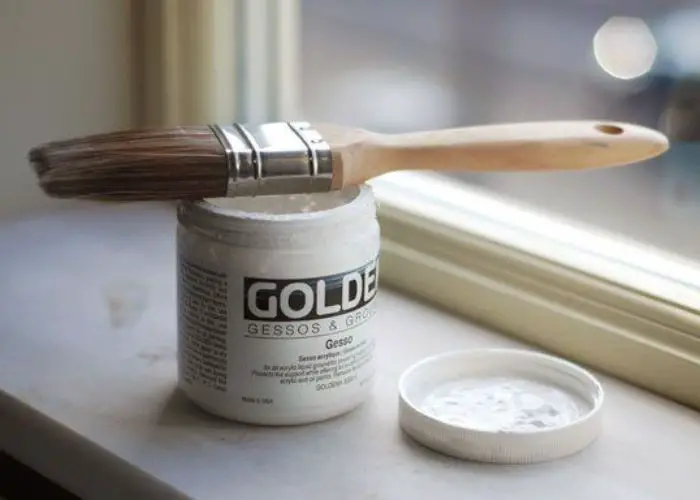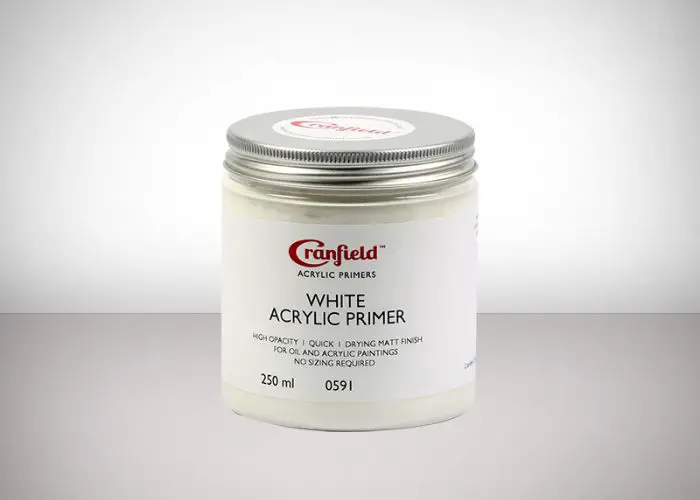What does “acrylic” mean in relation to painting? What is acrylic primer, and what are its uses? In this blog post, we will answer your questions about acrylic primer.
Acrylic primer is a type of paint that is made up of two components: pigment and binder. The binder in acrylic primer is usually an acrylic resin.
This type of resin creates a strong bond with the surface it is being applied to, making acrylic primer ideal for use on many different surfaces, including metal, wood, plastic, and walls.
What is Acrylic Primer?
Acrylic primer is a type of paint that is made up of two components: pigment and binder. The binder in acrylic primer is usually an acrylic resin. This type of resin creates a strong bond with the surface it is being applied to, making acrylic primer ideal for use on many different surfaces.
What Does Acrylic Mean in Paint?
The term acrylic is used to describe a type of synthetic polymer that is derived from acrylic acid.
In paints, acrylic is used as a binder – the substance that holds the pigment together and gives the paint its overall structure.
Acrylic binders are known for their exceptional durability, which is why they are often used in high-quality paints.
As a result, acrylics are widely used in many different industries, including the paint industry.
In fact, acrylics are one of the most popular types of binders used in water-based paints.
Other Posts: Can I Mix Acrylic Paint With Resin?
Acrylic Paint Basics

Acrylic paint is a fast-drying paint made of pigment suspended in an acrylic polymer emulsion. Acrylic paints are water-soluble but become water-resistant when dry.
Depending on how it is mixed and used, it can resemble oil paint, watercolor, or gouache. But first, what is the difference between gouache and acrylic paint?
Unlike oil paint, however, it cannot be dissolved in turpentine or other solvents.
Many artists favor acrylic paint for its versatility. It can be thinned with water to create washes or used straight from the tube to create thick, textured strokes.
It can also be mixed with other media, such as pastels or charcoal, to create unique effects.
In addition, acrylic paint dries quickly, which allows artists to work faster and make corrections more easily. Despite its many advantages, acrylic paint has some drawbacks.
For example, it is not as resistant to sunlight as oil paint and can yellow over time when exposed to light. Acrylic paint also has a tendency to crack when applied over a large area.
For these reasons, it is not always the best choice for paintings that will be hung in direct sunlight, murals, or other large-scale works.
What Is Acrylic Paint Primer?
Acrylic paint primer is a seal and prepares surfaces for painting. It is also sometimes called an acrylic gesso.
Gesso is a compound made of chalk or gypsum mixed with an adhesive binder that is used as a ground or base layer for painting. It is available in two forms; home made gesso and pre-made gesso.
Some acrylic gesso uses include preparing paper and other oil or acrylic painting surfaces. The word “primer” comes from the Latin word “prime,” which means first.
In the world of painting, a “first coat” or a “priming coat” is a preparatory coat of paint that helps the subsequent coats of paint to adhere better and achieve better color quality.
A good quality primer will improve your paint job’s durability, appearance, and uniformity.
It can also help extend your paint job’s life by protecting against UV damage, mold, and mildew. Acrylic paint primers are available as water-based or oil-based products.
Water-based acrylic paint primers
Water-based acrylic primers are typically white in color and have a milky consistency.
They are designed to be used on porous surfaces like wood, drywall, and concrete.
Water-based acrylic primers are also available in clear formulations that will not change the color of the surface you are painting.
Oil-based acrylic primers
Oil-based acrylic primers are designed for use on non-porous surfaces, such as metal, glass, and plastic.
They are typically clear or pigmented with a color that is similar to the paint you will be using.
Oil-based acrylic primers can also be used on porous surfaces, but they may take longer to dry.
In addition, oil-based primers have high VOCs (Volatile Organic Compounds) and are not as environmentally friendly as water-based primers.
Does acrylic paint need primer?
Yes, acrylic paint requires a primer when used on porous surfaces to ensure even absorption and a smooth finish.
Priming also increases paint adhesion, reducing peeling or chipping. Common primers for acrylics include gesso for canvases and sealers for wood.
What is Acrylic Primer Used For?
Acrylic primer prepares surfaces for oil or acrylic painting by sealing the substrate’s fibers and creating a slightly absorbent, textured base. It can be transparent, white, or tinted, applied in thin layers for optimal results.
- Acrylic primer is a type of paint primer that is used to prepare surfaces for painting. It is typically used on porous surfaces like wood, concrete, or drywall. Here is how to seal acrylic paint on concrete for better protection.
- Acrylic primer helps to seal the surface and provides a smooth surface for the paint to adhere to.
- It also helps to prevent the paint’s peeling, flaking and chipping. Acrylic primer can be used on both interior and exterior surfaces.
- However, it is important to note that it is not recommended for use on surfaces that are exposed to direct sunlight or extreme heat.
How to Use Acrylic Primer

Acrylic primer should be applied with a brush, roller, or sprayer. It is important to work in small sections and use even strokes. Once the primer is dry, you can apply the top coat of paint.
When applying primer with a brush, start by dipping the brush into the primer.
Tap off any excess and then apply the primer to the surface in a steady back-and-forth motion. Work in small sections, and be sure to overlap each stroke.
If you use a roller, start by pouring the primer into a paint tray. Next, dip the roller into the primer and then roll it onto the surface.
Again, work in small sections and be sure to overlap each stroke.
When using a sprayer, start by holding the nozzle about 12 inches from the surface.
Then, apply the primer in a steady back-and-forth motion. Be sure to hold the sprayer at a consistent distance from the surface and use even strokes.
Acrylic Primer for Canvas
It is recommended to use an acrylic primer for canvas. A primer will help create a smooth painting surface and prevent the paint from sinking into the fabric.
Canvas is a porous surface, so you may need to apply multiple coats of primer to achieve a good seal. You can also use gesso to prime your canvas.
Gesso is a compound made of chalk or gypsum mixed with an adhesive binder that is used as a ground or base layer for painting.
We recommend using U.S. Art Supply White Gesso Acrylic Medium or a homemade floetrol for quality results.
Applying Primer to Canvas
- To apply primer to the canvas, start by laying the canvas flat on a surface that you can cover with a drop cloth or newspaper.
- Next, apply the primer to the canvas using a paintbrush, roller, or sprayer. Work in small sections and use even strokes.
- Allow the primer to dry completely before applying the top coat of paint.
Remember to protect your work; here’s a detailed guide on how to protect canvas paintings.
Acrylic Primer for Walls
Acrylic primer can be used on walls, but it is not always the best choice. Acrylic primer is designed for use on porous surfaces, and walls are not always porous.
Also, if your walls have been painted before, they may have a sealant that makes them non-porous.
Still, there’s a perfect primer for your acrylic walls that you can use, INSL-X SXA11009A-04 Stix Acrylic Waterborne Bonding Primer.
Acrylic Primer for Plastic
Acrylic primer can be used on plastic, but for optimal results, use acrylic paint formulated specifically for plastic surfaces.
It ensures better adhesion and durability. Does acrylic paint work on plastic? Yes, when using the right type of paint
For example, acrylic primer may not adhere well to certain types of plastic, such as polyethylene or PVC.
If you are unsure whether or not your plastic surface is compatible with acrylic primer, it is best to test the primer in an inconspicuous area before proceeding.
Use Vallejo Grey Primer Acrylic Polyurethane for your plastic project.
Acrylic Primer for Wood
Acrylic primer can be used on wood, but it is not always the best choice.
Acrylic primer will adhere well to wood but may not provide as much protection as a stain-blocking primer.
Acrylic primer may not adhere well to certain types of wood, such as cedar or redwood.
Therefore, if you want to paint wood such as MDF with acrylic, we recommend you use Zinsser 02004 Bulls Eye Primer because it is water-based and hence bonds well with acrylic paint.
Acrylic Primer for Metal
Acrylic primer can be used on metal surfaces, but it is not always the best choice.
For example, acrylic primer may not adhere well to certain types of metal, such as aluminum or stainless steel.
If you are unsure whether or not your metal surface will accept an acrylic primer, it is best to test the primer in an inconspicuous area first.
If the results are not pleasing, try using Rust-Oleum 207016 Marine Metal Primer because it is durable and corrosion-resistant.
Acrylic Primer for Acrylic Nails
Professional Quality – Cacee Acid Free Primer
Looking to create the perfect adhesive base for your gel nails or natural nail? Look no further than Cacee’s Acid-Free Primer!
These nail primers are perfect for creating a strong foundation before applying your favorite gel polish.
It also helps to prevent lifting and ensures your nails stay looking their best for weeks on end.
Best of all, the low odor formula is gentle on your nails and skin. Additionally, it also works well with nail prep dehydrator.
So why wait? Add cacee’s acid-free nail primer to your beauty arsenal today!
Exterior Acrylic Primer
Exterior acrylic primer is a type of primer that is specifically designed for use on outdoor surfaces.
Exterior acrylic primer can be used on wood, metal, or plastic surfaces. Choosing an exterior primer compatible with the type of paint, you will be using is important.
Try the above-discussed primers on your exterior surfaces and you will sure love the results.
Best Acrylic Primer
The best acrylic primer is the one that is specifically designed for use on the type of surface you are painting.
If you are unsure what type of primer to use, it is best to consult a professional paint store or contractor.
Our overall best pick is the Vallejo Grey Primer Acrylic. This primer can be used on a variety of surfaces and provides excellent coverage.
For best results, follow the manufacturer’s instructions for application and drying times.
Conclusion
Primers are an important step in the painting process. They create a smooth painting surface and help prevent paint from sinking into the fabric or substrate.
Many different types of primers are available, and each is designed for use on a specific surface type.
Therefore, it is important to choose the right primer for the job. If you are unsure what type of primer to use, it is best to consult a professional paint store or contractor.










Leave a Reply